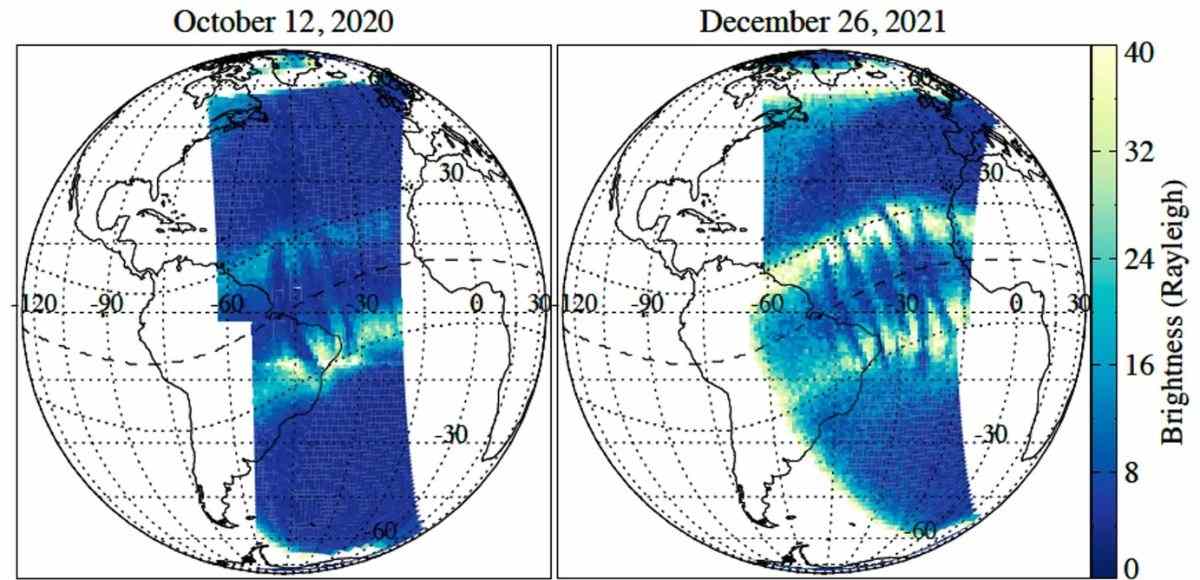NASA’s Global-scale Observations of the Limb and Disk (GOLD) mission spotted X and C-shaped structures within Earth’s ionosphere. This layer of Earth is mostly made up of electrically charged plasma or gas and is crucial for radio communication.
In this article, we will learn about NASA's GOLD mission's role in studying the ionosphere's response to atmospheric events, solar radiation, and geomagnetic storms, and the implications of these findings on our understanding of space weather and communication systems.
What is NASA’s GOLD Mission?
The Global-scale Observations of the Limb and Disk (GOLD) mission, launched by NASA in 2018, involves a geostationary satellite aimed at studying the Earth's ionosphere-thermosphere system.
The mission focuses on how this system responds to geomagnetic storms, solar radiation, and atmospheric waves and tides.
GOLD utilizes two ultraviolet (UV) imaging spectrographs to monitor densities and temperatures in the thermosphere and ionosphere with unprecedented detail, enhancing our understanding of the ionosphere's dynamics.
Science Quiz On Space Debris With Answers
Role of Ionosphere
The shape of Earth’s magnetic field (represented by orange lines in this data visualization) near the equator drive charged particles (blue) away from the equator; Video: NASA
The ionosphere in Earth's upper atmosphere serves as a boundary between our planet and space, housing phenomena like auroras, satellites, and radio communication waves. Spanning from 37 miles (60 km) to 620 miles (1,000 km) in altitude, it contains a dense concentration of ions and electrons. This layer interacts crucially with radio signals, and disturbances can lead to disruptions in GPS signals on Earth.
During the day, the density of this layer increases as sunlight causes electrons to detach from atoms and molecules, creating plasma bands of charged particles that influence Earth's magnetic field and facilitate communication systems.
At night, the ionosphere's density decreases, and low-density bubbles can form, potentially interfering with radio and GPS signals. Apart from the impact of sunlight, the ionosphere is also sensitive to solar storms and significant volcanic eruptions, which can cause the crests to merge into an X shape.
What is Space Junk (Debris) and why is it a global threat?
Significance of GOLD findings

NASA’s GOLD mission shows charged particles in the ionosphere forming an X shape on Oct. 7, 2019. (The colours indicate the intensity of the ultraviolet light emitted, with yellow and white indicating the strongest emission, or highest ionospheric density.); Image: F. Laskar et al.
Previously, X-shaped structures in the ionosphere were observed during geomagnetically disturbed conditions. However, GOLD detected these structures during geomagnetically quiet times, suggesting that lower atmospheric events may have a more substantial impact on the ionosphere than previously thought.
Fazlul Laskar, a research scientist at the University of Colorado's Laboratory for Atmospheric and Space Physics (LASP) and lead author of a paper published in the Journal of Geophysical Research: Space Physics, said, “Earlier reports of merging were only during geomagnetically disturbed conditions. It is an unexpected feature during geomagnetic quiet conditions.”
 NASA’s GOLD mission shows C-shaped and reverse-C-shaped plasma bubbles; Image: D. Karan et al.
NASA’s GOLD mission shows C-shaped and reverse-C-shaped plasma bubbles; Image: D. Karan et al.
In addition to the X-shaped structures, GOLD also observed C-shaped and reverse-C-shaped bubbles approximately 400 miles (643 kilometres) apart (roughly the distance between Baltimore and Boston), indicating unexpected changes in wind patterns. These findings suggest drastic changes in wind patterns over short distances, which is quite unusual.
Deepak Karan, another LASP research scientist and lead author of a separate paper published in the Journal of Geophysical Research: Space Physics, explained that such strong disturbances in the plasma could completely disrupt signals in the affected region.
Why Are There Stones On Railway Tracks?
Ongoing Research
The study of the ionosphere is not new. The Atmospheric Perturbations Around The Eclipse Path (APEP) project investigated how a decrease in sunlight and temperature affects Earth's upper atmosphere.
During the total solar eclipse on April 8 across North America, NASA launched three suborbital sounding rockets into the eclipse path to measure changes in electric and magnetic fields, density, and temperature within the ionosphere. The results of these missions are still pending.
These ongoing studies, including GOLD's recent findings, continue to shed light on the complex interactions within Earth's ionosphere, contributing to our understanding of space weather and its impact on communication systems. The findings could play a crucial role in the development of space weather forecasting capability.
Comments
All Comments (0)
Join the conversation